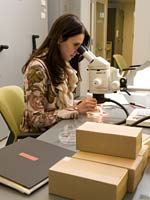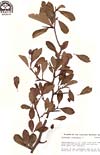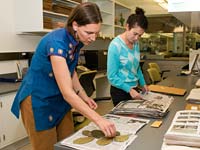
A Multifaceted Resource
A herbarium (say the “h”) is a place where preserved plants are collected and classified. The Chicago Botanic Garden’s Nancy Poole Rich Herbarium is home to 12,000 specimens of plants—from our own Cook County backyard and the Upper Midwest—all the way from Russia, Korea, and China. This biological library enables scientists from around the world to identify plants in our region and to determine where rare species may be located. Over the years, scientists have realized how important these collections are in documenting and understanding our region’s natural history.
The Herbarium also is an important resource to train staff and volunteers to be able to identify native and invasive plants and to teach students about plant taxonomy and morphology. The Herbarium is not open to the public, but an interactive exhibit displays sample specimens and reveals how the Herbarium helps us understand the Midwest’s natural history, present, and potential future.

Herbarium Plants and Climate Change
Studying specimens in the Herbarium is helping scientists determine how climate change is affecting midwestern plants. By analyzing plants collected at the same developmental stage (e.g., when they begin to flower) throughout different periods in our history, scientists can determine if plants are flowering earlier in the season than they were long ago. And, if plants bloom in response to rising temperatures, their earlier flowering potentially could be linked to climate change. Citizen scientists are expanding our data. Chicago Botanic Garden's Budburst participants help track and document regional growing cycles as they relate to climate.
Understanding Plant Relationships
In addition to determining the impact of climate change on plant growth patterns, study of Herbarium samples can demonstrate how species are related to one another. Consider sunflowers as an example. Sunflowers are used as a food and oil crop. If we want to improve that crop in some way, we can assess the qualities of different sunflower species (e.g., one may have better oil content or produce larger or more nutritious seeds).

Understanding relationships among the species of sunflowers may lead to a more informed breeding process. Traditionally, scientists have studied plant relationships by analyzing morphology and anatomy, but investigating DNA samples of specimens in the Herbarium is a more expedient and reliable method. Precision is especially important when considering plants for drug exploration. The cancer fighting properties in Taxol were discovered in a native species of yew from the Pacific Northwest. If we understand taxonomic relationships among the species of yew, we could perhaps find other useful chemicals in close relatives of this species, or perhaps find a cultivated species that produces the same compound.
Assessing the Past and Future of Plant Distribution
Studying Herbarium specimens enables us to document the distribution of plants at different times: we learn where plants grew in the past compared to where they are abundant today. For example, we know that invasive plants such as garlic mustard and buckthorn were not nearly as pervasive in our region a hundred or two hundred years ago as they are today.
Virtual Herbarium
In partnership with The Morton Arboretum and The Field Museum, and with funding from the Institute of Museum and Library Services, the Chicago Botanic Garden also makes its herbarium database and images available online via vPlants: The Chicago Regional Virtual Herbarium. The site contains data for 80,000 plant specimens, and can provide real-time reference for scientists in the field. With this resource, scientists can quickly identify a plant species and assess if they have uncovered a new find!

